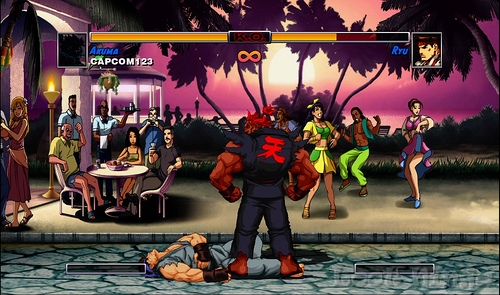H is for Hidden Characters
by Sindra, filed in Games, Powet Alphabet on Aug.22, 2009
 Since the alphabet is the building block of our language, the Powet Alphabet is the building block of what makes us geeks.
Since the alphabet is the building block of our language, the Powet Alphabet is the building block of what makes us geeks.
Don’t you love surprises? Like when you open a present for your birthday and actually got what you wanted or you wear an old pair of pants and find a $20 bill in them from last season? Surprises help keep life interesting and fresh, as we never know what could happen next and what the next surprise could be. This concept has been reflected upon by various forms of media to keep them fresh and interesting as well, and video games are no exception. One of the all-time great surprises video games have always had in store for us gamers is the concept of the hidden character – i.e. A secret member of the cast that does not show up on the initial roster and must either be found in-game or made accessible through various means.

Back in the early-to-mid 90’s, video games began throwing in “Easter Eggs” and hidden items all over the place, in order to keep the player guessing and to extend replay value. Knowing that there were extra parts thrown into a game that, while not necessary to complete the game and rather were there for the sake of challenge, gave many players more reason to keep playing. One of the best known games for its hidden characters was the Mortal Kombat series. Starting from the very first game, you were given 7 players to choose from initially, and then had one hidden character – Reptile. Reptile would randomly appear before matches to tease his existence, and could only be fought against after a complex series of requirements were met. In Mortal Kombat II, three hidden characters were smuggled into the game – Jade, Smoke and Noob Saibot – with varying degrees of difficulty in terms of how to gain access to fight each one. By this time, the concept of hidden characters becoming popular enough to be put into sequels as playable characters became common, as Reptile was in MKII and the MKII crew being put into Ultimate MK3. Street Fighter emulated this with making Akuma, a boss, also a hidden playable character in Street Fighter II Turbo. Other game series like Tekken award secret characters after certain requirements are met.

 As you can see, hidden characters are most commonly found in fighting games. Soul Calibur, Marvel vs. Capcom, Super Smash Bros. and Dead or Alive are other prime examples of games sporting secret playable fighters. Hidden characters aren’t strictly found in fighting games, however. Resident Evil 2 featured HUNK and spoof character Tofu was unlockable scenario characters after beating the game’s initial scenarios with Leon and Claire. In many Castlevania games from Symphony of the Night and beyond, after beating the game on regular mode with the main character, you have the option to play as secondary hidden characters in their own modes. Likewise, in some games there are hidden bosses that can be found and fought after requirements are met, such as Ozzie, Slash, and Flea being available to fight in Chrono Cross after starting a New+ game, and the inclusion of the optional Sephiroth battle in both of the Kingdom Hearts games.
As you can see, hidden characters are most commonly found in fighting games. Soul Calibur, Marvel vs. Capcom, Super Smash Bros. and Dead or Alive are other prime examples of games sporting secret playable fighters. Hidden characters aren’t strictly found in fighting games, however. Resident Evil 2 featured HUNK and spoof character Tofu was unlockable scenario characters after beating the game’s initial scenarios with Leon and Claire. In many Castlevania games from Symphony of the Night and beyond, after beating the game on regular mode with the main character, you have the option to play as secondary hidden characters in their own modes. Likewise, in some games there are hidden bosses that can be found and fought after requirements are met, such as Ozzie, Slash, and Flea being available to fight in Chrono Cross after starting a New+ game, and the inclusion of the optional Sephiroth battle in both of the Kingdom Hearts games.
Like many other staples in video gaming history, hidden and secret characters are a special spice that adds extra flavor to a game. Is it necessary to make a game fun? Hell no. Does it help add replay value and extra sport to perhaps an already great game, or even a mediocre one? You bet your silhouetted outline in does. (See what I did there?)


 PS3
PS3
 Famicom Dojo
Famicom Dojo KEEP PLAYING
KEEP PLAYING KEEP PLAYING: Rewind
KEEP PLAYING: Rewind Powet Toys
Powet Toys Powetcast
Powetcast Hitchhiker's Guide POWETcast
Hitchhiker's Guide POWETcast














